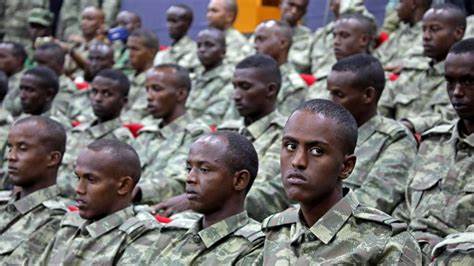Somalia stands at the precipice of disaster. The imminent withdrawal of the African Union’s Transition Mission in Somalia (ATMIS) by December 2024 heralds a grim and blood-soaked future. Expert analyses and recent data from the Armed Conflict Location and Event Data (ACLED) paint a terrifying picture: without the stabilizing presence of ATMIS, Somalia’s national army (SNA) is woefully unprepared to face the ferocious resurgence of the al-Shabaab insurgency.
The Federal Government of Somalia (FGS), buoyed by a dangerous overconfidence, believes it can sustain security without ATMIS. However, this decision reeks of betrayal—not only to the Somali people but also to the international community that has invested blood and treasure into stabilizing this war-torn nation. External partners, worn down by the financial burden, have decided to wash their hands of Somalia, leaving it to fend for itself against a relentless and well-coordinated terrorist force.
Al-Shabaab, sensing the approaching vacuum, has ramped up its attacks. ACLED reports nearly 100 assaults on Somali and ATMIS forces within a single month. The majority targeted Ugandan forces in Lower Shabelle, revealing a strategic focus on areas where ATMIS has historically been strongest. This surge in violence is not random; it’s a calculated move to reclaim and expand their control over critical regions and supply routes, setting the stage for a broader offensive once ATMIS departs.
The SNA’s structural weaknesses are glaring. Chronic corruption within the military hierarchy siphons off essential resources, demoralizing troops and weakening operational effectiveness. Recent scandals, including the diversion of U.S.-donated food rations by senior officials, have exposed the rot at the core of the SNA. This corruption scandal led to the suspension of food rations to the elite Danab forces, causing withdrawals from strategic villages and allowing al-Shabaab to recapture lost territories.
Internal strife compounds these problems. Infighting among clans and animosity towards the FGS have fractured the coalition against al-Shabaab. These disputes over power-sharing and land have erupted into armed clashes, further destabilizing the regions meant to be fortified against terrorist advances. The FGS’s failure to maintain support from clan militias has only emboldened al-Shabaab, who exploit these fissures to their advantage.
While the SNA is expected to retain some level of international support post-ATMIS, this assistance is a double-edged sword. Over-reliance on external partners has fostered a dangerous dependency, leaving the SNA ill-equipped to operate independently. Moreover, the coordination among international partners—each with their own political agendas—remains a logistical nightmare, undermining the potential effectiveness of continued support.
Al-Shabaab’s psychological operations have been devastatingly effective. Their messages of endurance and inevitability resonate deeply within Somalia, eroding the morale of the SNA. Despite initial successes in 2022, the SNA’s confidence has waned, unable to sustain momentum against a resilient and adaptive foe. The lifting of the UN arms embargo and the influx of new recruits offer little solace when faced with an enemy that thrives on ideological fervor and strategic cunning.
As the AU forces prepare to withdraw, Somalia braces for a wave of violence unlike any seen in recent years. The SNA, already stretched thin and plagued by inefficiencies, will face hundreds of additional attacks annually. These assaults, previously absorbed by ATMIS, will now fall squarely on the shoulders of a beleaguered national army. Al-Shabaab’s preferred weapon—improvised explosive devices—will wreak havoc on an ill-prepared and vulnerable military.
The international community must recognize the impending catastrophe. It is imperative to extend and amplify support for Somalia’s security forces, focusing on long-term capacity building rather than short-term fixes. Additionally, the FGS must undertake profound reforms to root out corruption, mend clan divisions, and forge a unified command structure. Without these critical changes, Somalia risks becoming a failed state overrun by terrorists, a breeding ground for extremism, and a significant threat to regional and global stability.
The abandonment of Somalia by the AU and its international partners is a monumental failure of moral and strategic foresight. As al-Shabaab gears up for a renewed campaign of terror, the SNA finds itself in an unenviable position: outgunned, outmaneuvered, and on the brink of collapse. The coming months will be crucial. Without decisive action and unwavering support, Somalia’s descent into chaos is all but guaranteed. The world cannot afford to turn a blind eye.







Discussion about this post